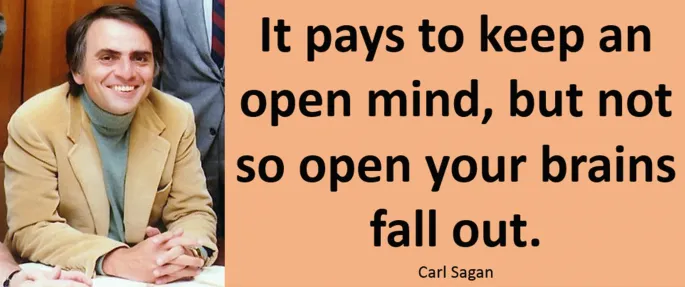The Telepathy Tapes Talk Tracks Two: Back for More
Mark Honeychurch - 18th August 2025
In episode 9 of the Telepathy Tapes’ extra episodes, titled the Talk Tracks, host Ky Dickens has Adam Curry on to talk about the “science”, in an episode titled “The Science of Intuition: Consciousness, Intention, and the Edge of Reality”. According to Ky, dam is apparently an inventor and “deep thinker”, although in the episode he describes himself as an “armchair scientist” and “consciousness researcher” - although all I could find of his research online was a single paper on Google Scholar, where he is listed as the third author on a paper about retrocausation. Two websites I found that have profiles on him both listed many research papers, but none of the papers had his name attached to them, despite the fact that they were listed in one case on a website he owns, which sells an app he created (Entangled), and in the other case were listed on his profile page under a picture of him. So I’m left thinking that maybe he’s not so much of a researcher after all. Although even if he had been an author on those papers, looking at the quality of them and the places they’ve been published (and many haven’t been published anywhere) makes me think that it still wouldn’t be that much of a flex.
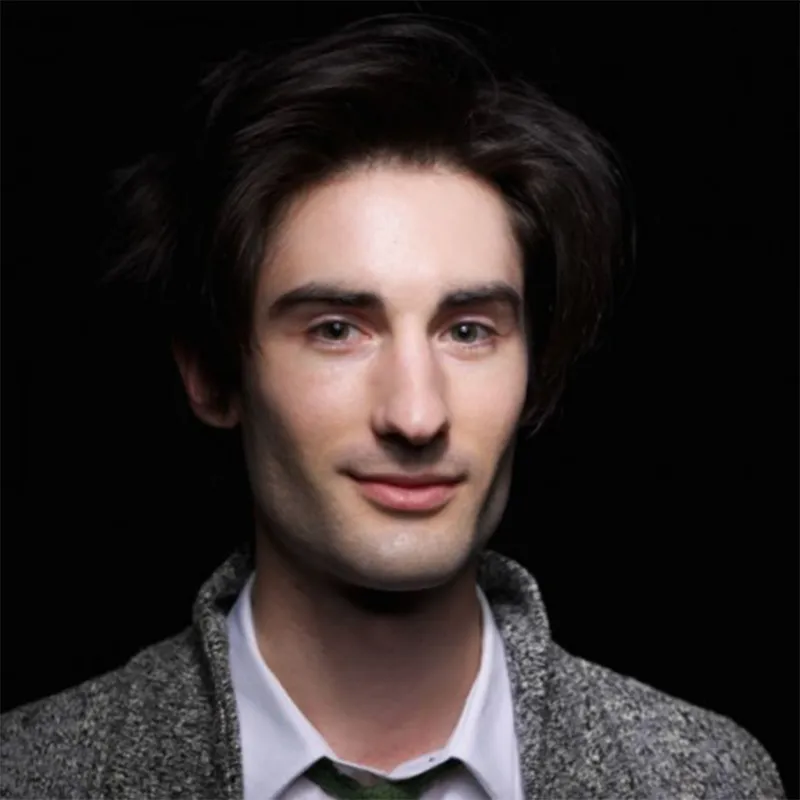
Adam Curry
The Interview
Adam starts off on the podcast name-dropping his Entangled app, as well as talking about the hot-topic at the moment, AI, and how that might have implications for Psi research. As an aside, it’s interesting that Ky Dickens is using the same Descript app that we at the NZ Skeptics use for our podcast to edit the Telepathy Tapes podcast. We currently don’t publish the text transcripts of our podcasts, as the work of fixing up all the little mistakes it makes would take far too long. Ky appears to have taken the more hands-off approach of just not fixing up these mistakes when she publishes her podcast episodes, with text captions, to YouTube. In just one example - this particular episode - Psi is talked about frequently, and it has the following uncorrected misspellings:
- Sci
- Site
- Psci
- Side
- Sigh
Adam gives a potted history of his interest and work in the field of Psi, starting with reading a book about Russian remote viewing. He was then employed by a friend’s father, both as a website administrator and a remote viewer. He’s then sidetracked by Ky into talking about presentiment studies, where apparently people have been shown to have a subconscious reaction (measured through galvanic skin response) to disturbing images in the seconds before the images are shown to them. From what I can tell he’s talking about Daryl Bem’s work - and Daryl is well known to skeptics as someone who’s spent years fishing for anomalous results that he can point to as evidence of supernatural goings-on. If you want to know more, Wikipedia has the dirt on how many other scientists suspect that Daryl’s (mis)use of what’s known as researcher degrees of freedom is what has led to some false positive results. However, the end of the controversy section contains the most damning evidence of issues, and it comes from Daryl’s own words, spoken to Slate during an interview:
“I’m all for rigor, but I prefer other people do it. I see its importance—it’s fun for some people—but I don’t have the patience for it… If you looked at all my past experiments, they were always rhetorical devices. I gathered data to show how my point would be made. I used data as a point of persuasion, and I never really worried about, ‘Will this replicate or will this not?’”
Back to Adam Curry - he goes on to try to explain that precognition would have an evolutionary advantage, and so therefore it’s scientific. Uhuh, and laser beams from our eyes and being able to defy gravity would also be advantageous if we evolved them, but for some reason we don’t seem to have managed either of those over the last few million years.
Adam is then asked about consciousness, and in his answer he arrives at the point of talking about the Global Consciousness Project - something I plan to write about for a future newsletter. We get a second mention of Adam’s Entangled app (more on this later), and then a question about working with Dean Radin. Although Wikipedia has some information about why Dean is not great at doing proper science, critical reviews of his books The Conscious Universe and Supernormal are a much better read.
Adam suggests that there’s more to life than the physical, and boldly states that materialism has been pretty much proven to be false. He has a gotcha explanation for this that I’ve had trouble getting my head around. Apparently materialism states that if something can’t be explained in terms of physical reality, it’s “not real. It’s an illusion”. But, Adam thinks there’s a logical inconsistency here, because “if it’s an illusion, what’s experiencing the illusion?”. He goes on to say that “it implies the existence of the thing it’s trying to argue against”. I think he may be trying to argue that illusions aren’t real, physical things, and so the existence of the illusion that something other than physical reality exists ipso facto disproves the idea that only physical things exist, because the illusion is not real, and yet it exists. My brain hurts!
Adam goes on to talk about the idea that our brains are nothing more than antennae that receive signals from our metaphysical, other-worldly consciousnesses - a common explanation for trying to justify a belief in mind-body duality. He waffles a little about philosophy departments in universities around the world, quantum effects and tubules, Roger Penrose, etc…
Ky then jumps in again with more of the same special pleading that I documented had been mentioned in the previous Talk Tracks episode. Apparently scientists should only come and study these children with telepathic powers if they believe that they are telepathic - no skeptical scientists allowed. Adam backs this up, saying that anyone testing these supernatural abilities not only need to have set a conscious intention to believe in them, but also need to understand this at a subconscious level. Supposedly having a mindset of disbelief is enough to alter the results of any study, causing them to have a negative outcome.
At this point the podcast goes off into speculative talk about AI, and how Adam has invented a new version of the Turing Test that evaluates whether an AI is human-like by evaluating whether it has telepathic abilities. Apparently if an AI can’t be telepathic, like we humans can, then it’s missing the “divine spark” that “makes us special”.
Ky asks whether in 50 or 100 years we’ll be looking back at materialists like we currently look at flat-earthers. This is kind of funny given that, to me, Ky Dickens constantly seems like she’s just one crank guest away from promoting flat earth beliefs. Adam responds to this with a quote from Dean Radin, and then somehow manages to inject Bitcoin into the conversation, while simultaneously letting the world know he’s an asshole. He says:
“Everyone gets Bitcoin at the price they deserve… if you were early, you had the opportunity to buy it cheap. However, if you didn’t read the white paper and you didn’t understand it and you dismissed it, or maybe you even attacked it, you said it’s magic internet money, it’ll never work, all these things, basically there’s an opportunity cost there for arrogance and for being too close-minded.”
This not only makes me think that Adam’s a tech-bro early adopter of Bitcoin, but also that he’s either unaware or uncaring about all the late-adopters of Bitcoin and other cryptocurrencies who have lost money, especially those in third world countries where any amount of investment will often involve a significant fraction of a family’s savings.
Anyway, this analogy is used as an explanation of why people like Adam are going to be at the cutting edge of science, technology and profit-making as they study Psi (sigh?) research.
Ky asks Adam about his Mind Lamp, which he describes as an RGB lamp that changes colour randomly. Apparently you can project your intention for it to change colour, and sometimes it changes to the colour you want - and this is supposedly a psychic power. But, if you try too hard, or want it too much, it might not work. So, if it works, psychic powers are real. And if it doesn’t work, psychic powers are still real, but you just don’t have the right mindset.
Springboarding from this, Ky asks about people’s intentions, and what effect they can have on psi abilities. Adam’s convenient answer, with no explanation of how this might work, is simply that if someone has bad intentions, for example if they want to do something negative with their psi powers, it just won’t work. I guess the Universe knows you’re going to use Remote Viewing to peer into changing rooms, and will stop you from doing it - unless, of course, your intentions for doing this are pure.
There’s a short conversation about whether we’re living in a simulation, and Adam suggests that because of quantum physics, a computer simulation, with its binary 1s and 0s, would look a lot like the world we live in. Then we get to some talk of The Matrix, and fanciful imaginings that maybe, like Neo, we can bend the rules of the computer code we’re living in. UAPs are mentioned, and Adam imagines that, with all of his and others’ research into these new phenomena, we may soon be living in a world with Jetsons-level technology.
For all of Adam’s talk about ushering in a new age of technological bliss, based on his research, how well is he doing? Well, from what I can tell his main output so far is his Entangled app (although it looks like, based on the success of the podcast, he’s planning to bring out a new version of his RGB light soon). So, how does the app work, and what has it managed to do so far?
The App
Apparently every user of Adam’s Entangled mobile phone app gets assigned a stream of quantum-generated random bits (from photons) that are generated at a rate of one 0 or 1 per second and recorded on a computer. Apparently each user will then be able to subconsciously control these bits, forcing them to stop being random and instead come out as a 1 or 0 at will. Paired with this, Adam believes that our collective subconsciousness may be superintelligent, potentially a new form of AI (I, however, think he’s just throwing new buzzwords into his nonsense to try to get more people interested in funding his work).
So, if our subconsciousnesses can work together to figure out hard stuff that we individually can’t, and we can each control our own single random bits to coerce them to a value we choose, we can supposedly use these two things to answer difficult questions. Adam’s app has 3600 channels, one for every second of each hour. Researchers can ask the app a question, choosing a set of parameters that designate what a positive answer would look like. If all this is a little confusing, you may want to go and read the explanation on the Entangled website.
It appears that after a year or more of running this app there’s just one “experiment” that’s being run - it’s about major earthquakes, and it’s “running” on channel 63. That means that on the 63rd second of each hour, a computer checks the quantum bits that have been generated for each user for that single second, and sees how close to the centre of the bell curve of probabilities the distribution of zeros and ones is. Obviously a fairly even ratio of 1s and 0s is going to be more likely than a distribution of all 1s or all 0s.
If the likelihood is below a certain threshold, which is set as part of the experiment’s protocol, then this registers as a positive result. The given explanation for this is that all our consciousnesses reached out simultaneously in the same second and collectively agreed to flip each of our bits to either a 0 or a 1.
I said “our” in the previous sentence because, yep, I signed up for the app. My first observation was that, unlike pretty much any other app I’ve ever signed up for, I was able to snag the username “mark” on Entangled. This tells me that nobody else has taken this username since the app was released, and I think that probably says a lot about the low number of users who have registered. Once registered, the app got stuck and I had to force quit it and restart it - not a great start.
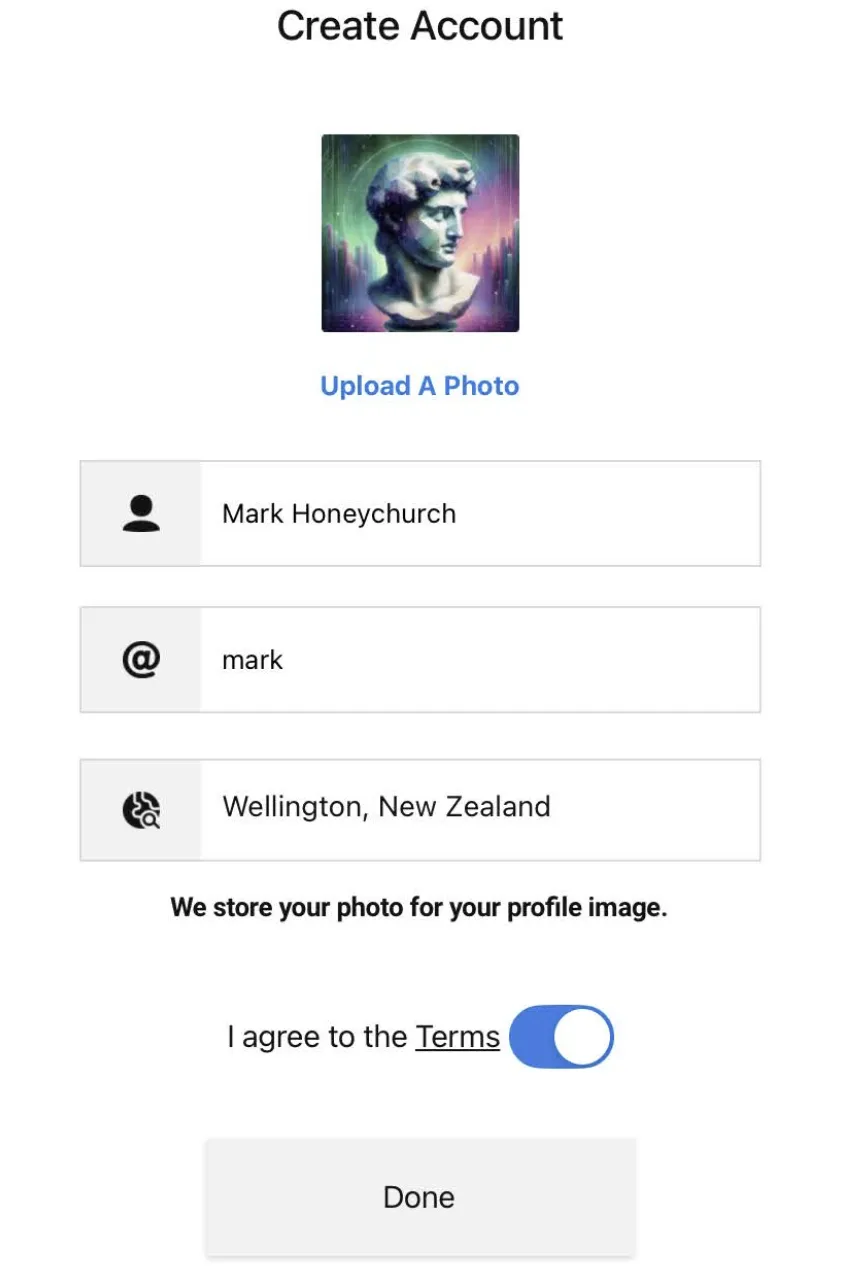
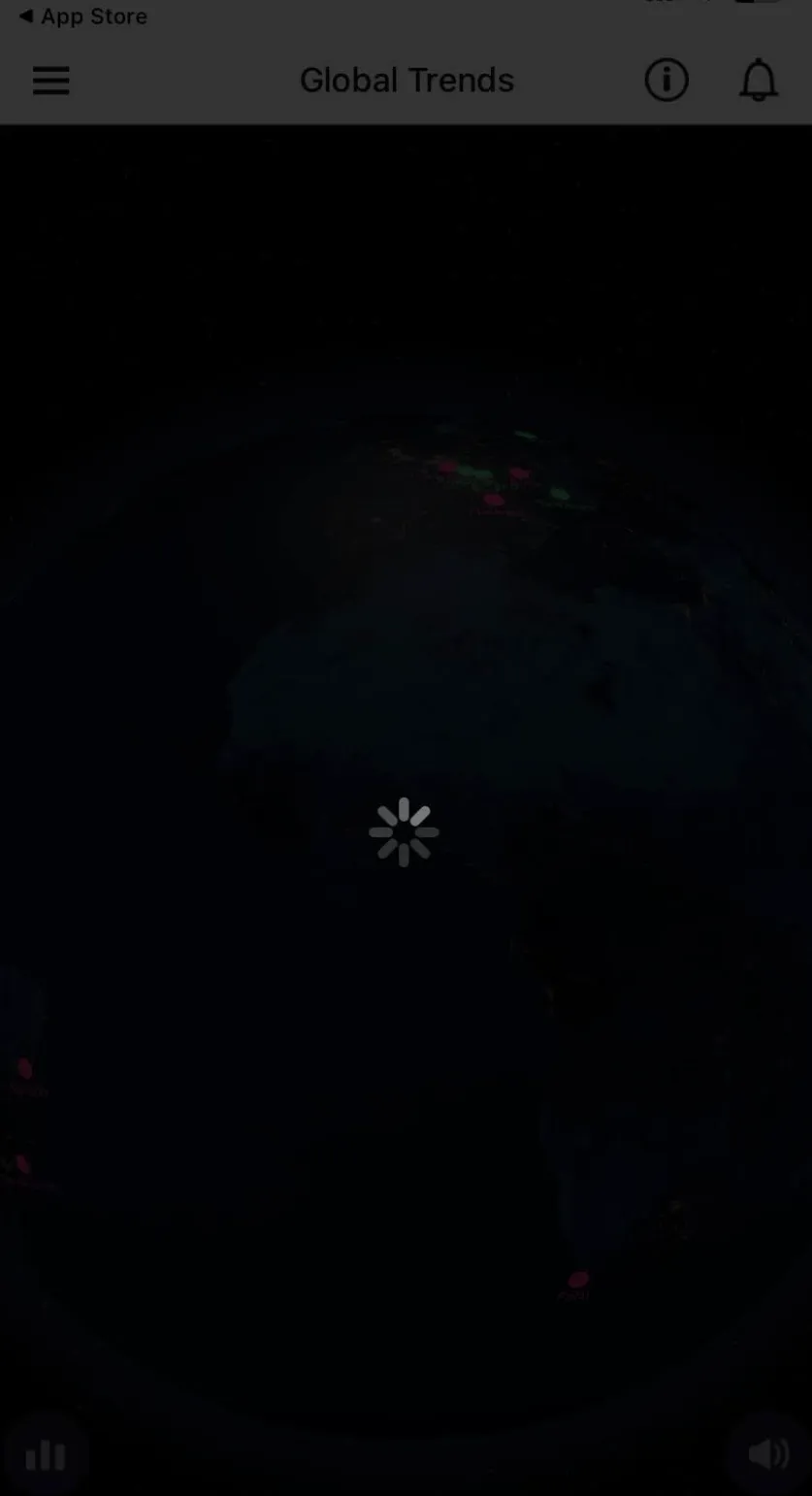
After restarting, I was able to see a pretty 3d model of the globe, with a list of cities that were currently experiencing supposedly anomalous results. This is due to users being assigned to the city they chose during sign-up, and their bits then being aggregated and checked for any low-probability results (a city with lots of 0s is pink, and one with lots of 1s is green).
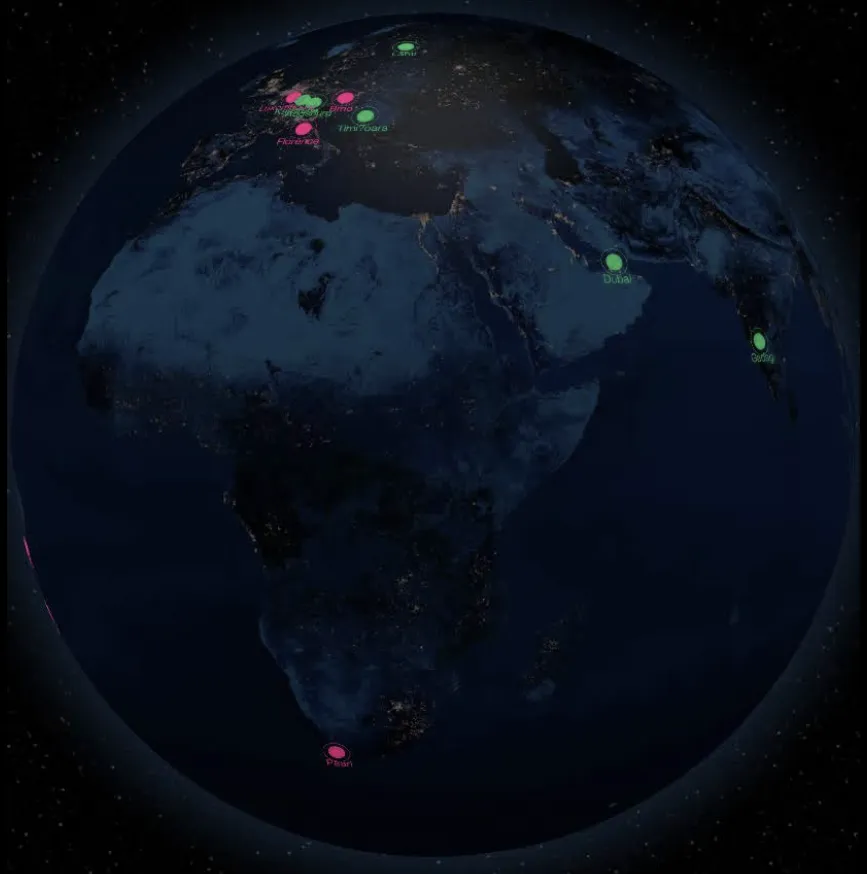
Luckily for you, you can see the same live globe map I have access to without having to install the app by just clicking on this link:
As well as this globe, I could also see the results so far this year of the earthquake prediction “study”, which boasted a 52% success rate:
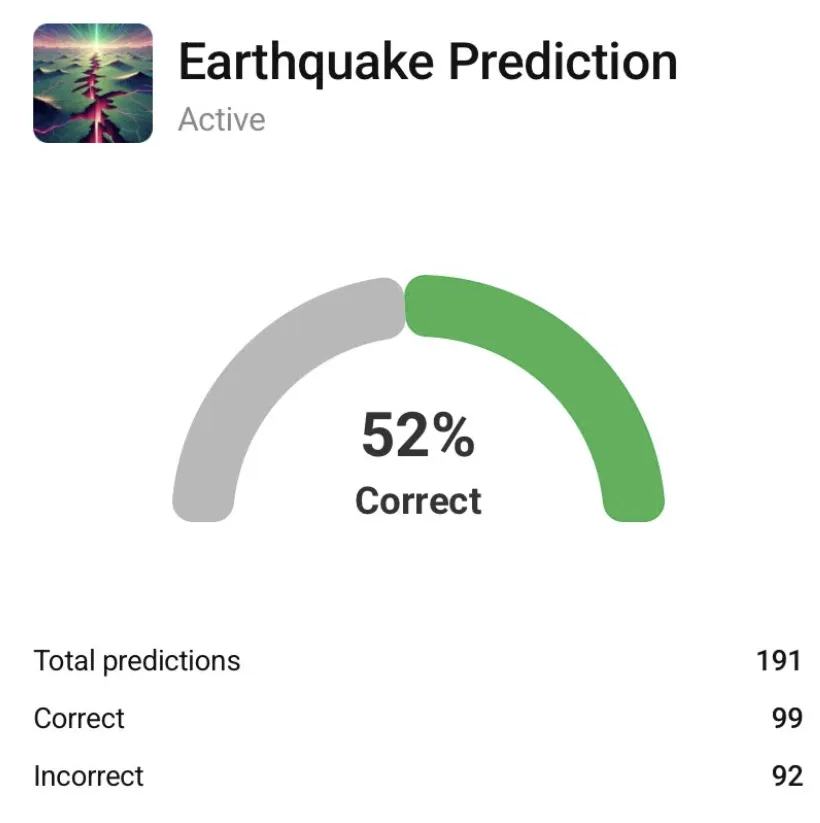
If this result was relative to tossing a coin, then 52% would be what you would expect from randomness. But it’s not - as I explained before, a question about earthquakes is posited and then channel 63 (the results on the 63rd second of every hour) is checked for results that deviate significantly from an even 0s/1s split. So, what exactly is the question that has been asked about earthquakes? The Entangled website doesn’t offer any details, but inside the app I could see some specifics:
Users participate by remotely influencing photon bits associated with the experiment (Channel 63), reflecting information their consciousness currently or will eventually access. Votes are recorded hourly, starting at 12 AM UTC, and continue until 11:59 PM UTC.
A major earthquake is defined as a magnitude 6.0 or greater event. Forecasts are made for the following day (in UTC time). Cumulative z-scores are calculated every hour for 24 hours. Positive z-scores (more 1s) forecast that an earthquake will happen, while negative z-scores (more 0s) forecast no earthquake will happen. Experiment duration is 3 months. Chi-square is calculated at the end of each. Data provided by USGS.
Okay, so it definitely looks like things might be a little more nuanced than just a 50/50 coin flip. We have the fact that it appears that results for multiple readings are merged, with readings from each of the 24 hours of a day combined. This gives a larger sample size than a single reading I guess, but I’m not sure it matters too much. Unlike the examples given in the explanation I read of how the app works, this experiment doesn’t seem to actually require a low probability result (lots of 1s or lots of 0s) to denote a Yes answer - it simply takes more 1s than 0s as a Yes, and more 0s than 1s as a No. So, it turns out that this result will likely look a lot like a coin toss - Yes roughly half the time, and No roughly half the time.
The last major variable we have here is related to the earthquakes. Eligible earthquakes have to be at least a magnitude 6.0. What bearing does the frequency of these earthquakes have on how the maths works?
There have currently been 230 days this year. We will assume randomness on the part of the number generator, so we’re imagining what would happen if the “collective subconscious” doesn’t affect the results. Let’s see what the year to date would look like under three different scenarios - a one in 100 chance per day of a 6.0 earthquake, at least one earthquake every day, and earthquakes about 50% of the time. I’m not going to do any hard maths here - mainly because I’d probably do it wrong! So, instead, I’m going to put my engineering degree to use and guesstimate things.
If large earthquakes are a very rare occurrence - for example, if there had been only two 6.0 or larger earthquakes this year - with a random 50/50 distribution of Yes and No, we’d expect, on average, one of the Yes answers to occur on one of the two earthquake days, and for a No to occur on the other. For the other days, where a No is a correct answer and a Yes is a wrong answer, all of the Nos would be correct, and the Yeses would be incorrect. By my guesstimation, this would leave us with a result of around 50% “success”.
If >6.0 earthquakes happened daily, all of the 50% of Yes days would be correct, and all of the No days would be wrong. Again we’d end up with a result of around 50%.
Now, if we imagine half of the days have an earthquake - 115 of them - and the Yes and No guesses are random, we’d expect half of the Yes days to align with an earthquake and half to align with a non-earthquake day. And the same for the inverse. So, again we have 50%.
Okay, all of this pseudo-statistics has told me that I probably misunderstood something fundamental, and that the way this experiment has been set up is actually like a coin toss, even with the addition of an earthquake strength variable. Oh, and for reference there have been around 90 magnitude 6 or above earthquakes this year - but it turns out that this number probably doesn’t really matter.
So the result of 52% within the app sounds to me like it’s pretty much in line with what we’d expect from randomness. Yes, it’s a little above 50%, but this is statistics, and 52% is still somewhere in the middle of the bell curve and perfectly normal (ooh, I think that might be an accidental maths pun). There doesn’t seem to be a way for me to access historical results in the app, but I have a suspicion they probably all look like they’re around 50% - because if they varied much from this, we probably would have heard about it by now.
I’ll end by attempting to fix a half-quote that host Ky Dickens uses at the end of every episode, when she says that “being a true skeptic requires an open mind”. Of course the entire quote, as often misattributed to Carl Sagan, is something along the lines of “it pays to keep an open mind - but not so open your brain falls out”.

